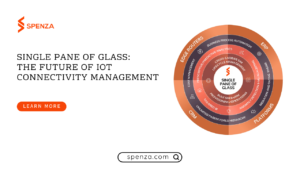TL;DR / At-a-Glance Summary
From Plastic SIMs to eSIMs
Remote eSIM turns activation into a software task, sending secure profiles to devices worldwide—no hardware needed.
Instant Global Device Rollouts
Skip shipping delays and manual swaps; activate and manage large fleets remotely in real time.
Scalable IoT, Simplified
One provisioning method manages multiple markets, networks, and device behavior effortlessly.
The New Standard
GSMA SGP.32-compliant, allowing over-the-air updates, plan changes, and rapid operator switching.
Spenza-Powered Orchestration
Remote eSIM provisioning becomes stronger inside Spenza’s orchestration system, where the platform manages activation, switching, and network decisions across many carriers with consistent control.

eSIM provisioning is the process of remotely activating and managing an embedded SIM (eUICC) on a device without a physical SIM card. It securely downloads a carrier profile over-the-air (OTA), enabling the device to connect instantly to a mobile network.
Problem with Physical SIM Card
What slows a business that tries to deploy thousands of devices across different regions? A physical SIM card forces long processes, because each rollout needs shipping, storage, labeling, tracking, and onsite handling.
These steps waste time, drain teams, and break momentum. They also grow more painful as global connectivity expands, and today the world already runs 16.6 billion connected devices. Every new device creates more demand for a faster activation model.
Remote eSIM provisioning solves this challenge by shifting activation into an over-the-air process that removes physical cards from the equation. This guide explains how the method works and why it matters for teams that want scale.
What Is Remote eSIM Provisioning?
Remote eSIM provisioning is a digital process that installs a carrier profile or operator plan onto the embedded SIM inside a device. The process replaces plastic SIM steps with secure, encrypted transfers that happen through software. Devices hold an eUICC chip, which lets them receive, store, and activate multiple plans through controlled, over-the-air commands.
This method works with eSIM provisioning rules that the GSMA maintains. These rules set the security model, the encryption used during installation, and the interactions between the device and the subscription manager. This forms a predictable system that supports global IoT connectivity without hardware changes.

The adoption of remote eSIM provisioning grows quickly because more IoT devices ship with embedded SIM hardware. The installed base of eSIM-capable IoT modules reached 650 million units.
The base concepts behind the embedded SIM and its role in remote eSIM provisioning stay clear when viewed through the simple explanation Spenza shares in its IoT eSIM introduction guide.
Remote eSIM provisioning also supports one hardware design for many markets. A company can build a single device model, ship it globally, and load the correct local plan during activation. It removes regional variations and reduces manufacturing work. This is one of the most practical eSIM benefits for companies that scale.
How Does Remote eSIM Provisioning Work?
Remote eSIM provisioning follows a structured sequence that aligns with GSMA SGP.32. The device includes an eUICC, which acts as the secure chip ready for new plans. When the device powers on, the platform triggers a request linked to the carrier plan assigned to that device.
The carrier creates the encrypted profile and stores it in a protected server. From there, the profile moves to the device through verified channels. Once installed, the plan becomes active, and the device connects to the network instantly.
This explains how eSIM works in simple terms. It links the embedded SIM with a secure cloud manager that delivers the operator profile through software rather than through a physical card.
A deeper version of this breakdown sits inside Spenza’s own guide on remote eSIM provisioning, where the flow connects with device lifecycle and orchestration systems.
Key parts of the process include:
- Encrypted profile creation
- Secure delivery to the device
- Instant activation
- Support for profile switching
- Support for multi-operator setups
- Local network selection without physical swaps
This structure removes friction across the entire fleet.
Tag devices in your system before shipping. Clear tracking makes remote eSIM provisioning smoother and reduces activation delays.
Remote eSIM Provisioning vs Physical SIM Cards
Physical SIM cards force manual action. Remote eSIM provisioning replaces that with software. The difference becomes noticeable when companies enter new countries or handle large fleets.
Physical SIM cards require stocking, shipping, distribution, and field labor. Remote eSIM provisioning requires none of that. It also reduces mistakes, shipping delays, and hardware handling.
| Factor | Remote eSIM Provisioning | Physical SIM Cards |
|---|---|---|
| Setup | Over-the-air digital process | Manual insertion |
| Network Switching | Software command | Remove and replace card |
| Global Expansion | One device model works everywhere | Region-specific SIMs |
| Inventory | No physical stock | Stored SIM packs |
| Security | Encrypted delivery | Card exposure in transit |
| Speed | Instant activation | Slow shipping cycles |
This table shows why companies now compare eSIM vs physical SIM when building modern IoT strategies.
Remote eSIM provisioning enables devices to be activated and managed entirely through digital workflows, eliminating the need for physical SIM cards. This not only accelerates global IoT deployments, but also empowers businesses with flexible network options, enhanced scalability, and a faster time-to-market — all without the delays of hardware logistics.
Benefits of Remote eSIM Provisioning for IoT, Enterprises & Global Deployments
Remote eSIM provisioning delivers a faster approach for IoT, field devices, and enterprise assets. It supports teams that deploy sensors, trackers, vehicles, kiosks, gateways, and tablets in many countries. Because the method sets device activation as a digital flow, companies reduce delays and manage everything through one system.

Zero Touch Creates Faster Rollouts
Remote eSIM provisioning helps companies activate fleets without shipping SIM cards or scheduling technicians. Plans move over the air, and devices boot with the right profile. This cuts delays and keeps deployment timelines steady even when teams work across many regions. Teams often include a few simple steps inside their activation playbook:
- Assign device
- Push profile
- Verify connection
- Begin operations
Shorter steps raise deployment speed without stressing staff. The global eSIM market already passed USD 10.68 billion in 2024 and is expected to reach USD 21.75 billion by 2030, based on a report from Bonafide Research. This growth reflects how many companies now replace physical SIM handling with digital provisioning to keep operational costs manageable.
Digital Control Replaces SIM Handling
Remote eSIM provisioning gives teams visibility and control through one dashboard. They trigger profile installation, enable new plans, or switch networks without local access. This turns network control into a simple workflow. Many companies place this into their routine operations because it:
- Removes onsite work
- Reduces errors
- Speeds network selection
Everything happens through software, which keeps the entire fleet consistent.
Local Profiles for Global Markets
Remote eSIM provisioning supports expansion by installing local carrier profiles when devices enter new countries. Devices connect quickly because the eUICC stores multiple plans. The process helps companies move into new regions with fewer steps. This also improves global IoT connectivity because devices choose networks with strong coverage.
Companies usually follow a pattern here:
- Ship device
- Power device
- Deliver local plan
- Begin activity instantly
This reduces downtime and improves connection reliability.
Reduced Field Costs
Remote eSIM provisioning helps companies cut labor because devices receive plans and updates digitally. Support teams fix issues remotely instead of sending staff to swap SIM cards.
This creates cost stability during growth. It also improves uptime because devices stay on the network while updates move through encrypted channels.
Spenza’s Role in Stronger Provisioning
Remote eSIM provisioning becomes more effective when orchestration surrounds it. Spenza’s platform manages activation, switching, and network choices across many carriers.
The system adds logic that supports large deployments, keeps devices stable, and gives teams predictable performance during scale. This flow aligns well with the broader needs of IoT teams.
Why Remote eSIM Provisioning Is Important for Large-Scale IoT Deployments
Large IoT deployments demand fast rollouts, flexible networks, and strong control. Remote eSIM provisioning helps companies meet these needs by turning activation into a digital event rather than a physical one. Today, over 120 countries support commercial eSIM connectivity. This wider support makes remote eSIM provisioning easier to rely on for cross-border operations.
Companies use one device model, ship it to any region, and load the correct plan in moments. This removes delays that appear when dealing with SIM packs and regional logistics.
Remote eSIM provisioning matters because global IoT connectivity grows fast. Teams work across borders, and device fleets travel to remote zones. The old physical model slows everything down. The digital model keeps fleets ready for new conditions, new operators, and new coverage needs.
Companies rely on it because they want:
- Quick activation across many countries
- A single hardware design
- Centralized control
- Secure plan delivery
- Smooth operator switching
These needs grow as fleets expand.
What Is eSIM Orchestration? (And How It Complements Remote Provisioning)
Remote eSIM provisioning activates profiles. eSIM orchestration manages everything that surrounds activation. It builds the rules, logic, network choices, switching conditions, and policies that devices follow. When combined, the two systems create a complete control layer for IoT deployments.
Orchestration also helps teams operate large fleets with predictable behavior. They see each device, track its status, and update its plan during movement. This helps teams avoid downtime and keep devices online across many markets.
The practical side of orchestration aligns well with the device-management approach Spenza describes in its eSIM enterprise BYOD guide.
Remote eSIM Provisioning Use Cases
Remote eSIM provisioning supports many industries because every industry now depends on stable, global IoT connectivity. Devices move, change zones, cross borders, and operate in remote locations. Physical SIMs slow this work. Digital provisioning supports it.

Fleet Tracking
Vehicles cross regions daily. Remote eSIM provisioning keeps trackers active by delivering new plans instantly. Devices switch networks without gaps, and fleets maintain visibility across long routes. Teams see consistent performance because the device selects strong networks.
Smart Manufacturing
Factories depend on sensors, controllers, and data streams. Remote eSIM provisioning supports this by allowing devices to receive plans without shutting equipment down. Machines stay active. Plants maintain flow. Teams change profiles quickly when coverage needs to shift.
Retail and Payments
Payment terminals must stay online during peak hours. Remote eSIM provisioning activates devices without in-store labor. Terminals stay connected, and teams resolve issues through digital actions. This keeps stores productive.
Agriculture and Remote Assets
Field equipment and sensors operate far from support staff. Remote eSIM provisioning helps teams manage devices across large areas. They send plan updates without driving out, keeping sensors productive across soil, crops, livestock, and equipment.
Logistics and Cold Chain
Shipments move across regions with strict conditions. Remote eSIM provisioning supports sensors that monitor temperature, location, and timing. Devices switch networks across borders, keeping shipments visible during long travel cycles.
Remote eSIM Provisioning Challenges No One Talks About
Remote eSIM provisioning solves many long-standing problems, but it still presents hidden barriers that companies must understand early. These challenges appear inside global deployments, low-power hardware, and complex operator environments. They also show up when teams try to maintain clean workflows across thousands of devices.
Some challenges come from device readiness. Not every device includes an eUICC, and not every eUICC supports advanced features. Other challenges come from poor operator support, missing APIs, and slow regional adoption of digital provisioning. These issues matter because remote eSIM provisioning depends on consistent behavior across systems, carriers, and devices.
Teams face a few common friction points:
- Limited device compatibility
- Older operator systems
- Region-specific rules
- Poor documentation from hardware vendors
- Profile download failures caused by weak signal
These friction points often resolve when teams use orchestration systems that handle retries, profile management, and logic paths. But companies still need clarity on what these challenges look like in real deployments.
| Challenge | Impact | Why It Appears |
|---|---|---|
| Inconsistent device support | Activation errors | Different eUICC versions across devices |
| Slow profile downloads | Delayed rollouts | Weak signal during bootstrap stage |
| Regional compliance gaps | Deployment pauses | Local policy changes |
| Operator limitations | Fewer profile choices | Carriers with older systems |
| Lifecycle confusion | Lost time | Teams juggling too many steps manually |
Remote eSIM provisioning works well once the system aligns, but companies benefit when they plan for these early. The digital nature of eSIM provisioning still requires strong oversight, predictable workflows, and clear responsibility across teams.
How Spenza Simplifies Remote eSIM Provisioning With Multi-Carrier Global Coverage
Remote eSIM provisioning works best when it sits inside a strong orchestration layer. Spenza builds that layer. The platform connects remote eSIM provisioning, eSIM provisioning, network choices, and lifecycle control into one hub that supports global IoT connectivity without slow processes.
Spenza uses a single interface where teams activate devices, switch profiles, assign carriers, and monitor connection quality. The system also uses logic that selects the right operator per region, which reduces manual configuration and shortens deployment time. As remote eSIM provisioning installs new plans, Spenza handles the routing, selection, and optimization automatically.
Companies choose Spenza because the platform supports:

- Multi-carrier activation flows
- Local profiles for international rollouts
- Automated switching across regions
- Clear visibility across all devices
- Strong policy controls
- Scalable orchestration for large fleets
These functions help teams manage many countries, many carriers, and many device types without building a custom network stack.
Spenza also fits into a simple ecosystem because it works with one hardware design. Companies ship devices globally, and the eUICC receives new plans as soon as the device powers on. The system reduces manual tasks and keeps deployments stable.
The Future of Remote eSIM Provisioning: iSIM, 5G, and AI-Driven Connectivity
Remote eSIM provisioning sets the foundation for the next generation of connected devices. The direction points toward integrated SIMs, smarter networks, and AI-based connectivity decisions. As networks shift toward 5G and narrowband models, devices need faster provisioning and smarter logic.
The next evolution—iSIM—moves the secure element inside the device’s chipset. Instead of a soldered eUICC, the SIM lives in the processor. This reduces cost, saves space, and increases security. iSIM works with the same provisioning model, so remote eSIM provisioning becomes remote iSIM provisioning over time.
5G also changes expectations. Devices move faster, roam across borders frequently, and need stable attachments to new networks. Remote eSIM provisioning supports this by delivering operator profiles fast and preparing devices for new coverage requirements.
AI plays a role by predicting which carrier a device should use next. It reads signal trends, movement patterns, and network behavior. It recommends the right moment to switch profiles. Combined with orchestration, the system becomes smoother because decisions move away from manual actions.
Remote eSIM provisioning remains the foundation that makes all of this possible.
Why Remote eSIM Provisioning Now Sits at the Center of Global Connectivity
Remote eSIM provisioning removes the physical steps that held companies back for years. It turns activation into a digital event that fits with modern IoT needs. Companies build one hardware design, install one embedded SIM, and use a secure digital workflow to assign networks across dozens of regions. This gives IT teams control without field labor and prepares fleets for global expansion without friction.
The method also supports eSIM provisioning and aligns with GSMA SGP.32, which helps devices stay ready for updates, new plans, and new carriers. This strengthens global IoT connectivity at every stage.
As more devices rely on cellular service in factories, vehicles, farms, stores, and remote sites, the need for simple over-the-air provisioning grows even stronger. The shift toward iSIM, smarter networks, and AI-driven decisions only pushes this forward.
So now the real question becomes simple, are you ready to let your devices connect smarter from day one?
FAQs
Yes. Profiles travel through encrypted channels, and the secure chip stores sensitive data. Because nothing ships physically, criminals cannot intercept or swap cards.
The device needs an eUICC, the correct firmware, and support for GSMA SGP.32. After that, the entire provisioning flow works through software.
Yes. Devices store multiple profiles, so they switch to better networks when needed. This helps sensors, trackers, and gateways maintain strong service even outside cities.
Want instant activation and reliable global reach for your IoT devices? Reach out to Spenza and use remote eSIM provisioning with orchestration built for real scale.






